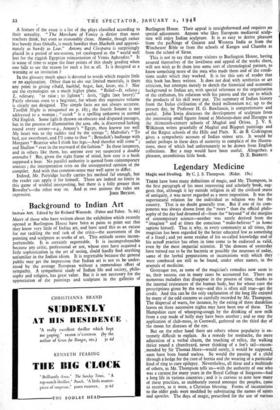Legendary Medicine
Magic and Healing. By C. J. S. Thompson. (Rider. 15s.)
THERE have been many definitions of magic, and Mr. Thompson, in the first paragraph. of his most interesting and scholarly took, sug- gests that, although it lay outside 'religion in all the civilised states of antiquity, it was never regarded as a mere imposition. It was the supernatural relation for the individual as religion was for the country. That is no doubt generally true. But if one of its com- ponents was always drawn from the more " than the official philo- sophy of the day had dreamed of—from the " beyond " of the margins of contemporary science—another was surely derived from the " imaginer " and at times the conscious " make-believer " in homo sapiens himself. That is why, in every community at all times, the magician has been regarded by the better educated few as something of a fraud ; and yet some residue of his so-called knowledge and of his actual practice has often in time come to be endorsed as valid, even by the most impartial scientist. If 'the demons of yesterclky have turned out to be the bacteria or possibly the neuroses of today, some of the herbal preparations or incantations with which they were combated are still to be found, under other names, in the arsenals of medicine.
Grotesque too, as some of the magician's remedies now seem to us, their success can in many cases be accounted for. There are numerous maladies that disappear in the process of time, thanks to the internal resistances of the human body, but for whose cure the prescriptions given by the way—and this is often still true—get the credit. And this can be the only explanation of the long life enjoyed by many of the odd customs so carefully recorded by Mr. Thompson. The dispersal of warts, for instance, by the eating of three dandelion leaves on three successive nights may have been one of these. The Hampshire cure of whooping-cough by the drinking of new milk from a cup made of holly may have been another ; and so may the application of club-moss, in Cornwall, gathered on the third day of the moon for diseases of the eye.
But on the other hand there are others whose popularity is ex- tremely difficult to explain. As a remedy for toothache, the mere adjuration of a verbal charm, the touching of relics, the walking thrice round a churchyard, never thinking of a fox's tail—recom- mended by Sir Thomas More—would surely, it would be supposed, soon have been found useless. So would the passing of a child through a hedge for the cure of hernia and the wearing of a particular kind of ring to cure epilepsy. Nevertheless, all these and a multitude of others, as Mr. Thompson tells us—with the authority of one who was a curator for many years in the Royal College of Surgeons—had a long life in various countries ; and it is curious to note how many of these practices, so stubbornly rooted amongst the peoples, came to receive, as it were, a Christian blessing. Forms of incantations to the older gods were modified by substituting the names of saints and apostles. The days of magic, prescribed for the use of various
ceremonies or applications, were altered to the holy days of the Church. And if most of these are a lesson in the unplumbable credulity of mankind, others are a reminder to us to be careful in too lightly dismissing them as the merest nonsense. In the infancy of our knowledge, for example, of cosmic rays who are we to be certain that some conjunction of stars may not have an effect on the human body?
In any case Mr. Thompson's book can be recommended as a fascinating guide to one of the lesser known but very real lanes of history, and %specially to the owners and lovers of gardens. For, when they hi:ore read it, their beds and borders will assume a new significance. They will learn that their laurels and rosemary were governed by the sun, whose metal was gold, and their mushrooms and melons by the moon, whose metal was silver. Their poppies owed obeisance to Saturn and their foxgloves and columbines to Jupiter, to say nothing of their parsnips. The elders in their hedges cured dropsy and jaundice, and their cranesbill the gotit. Their moonLclaisies were good" for insanity. Their lilies of the valley availed against apoplexy and their verbenas could do almost any- thing from defeating witches and curing the plague to obtaining lovers







































 Previous page
Previous page